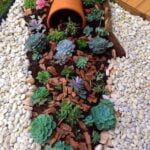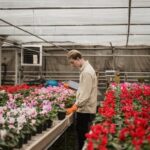Pot vegetable gardening is a popular and practical way to grow your own fresh produce, even in limited outdoor space or balconies. In this article, we will explore various pot vegetable gardening ideas to help you get started on your own mini garden. Whether you’re a beginner or an experienced gardener, these tips and suggestions will have you enjoying a bountiful harvest in no time.
By utilizing pots and containers for growing vegetables, you can easily control the soil quality, sunlight exposure, and water levels for each plant. This flexibility allows for customized care tailored to each vegetable’s specific needs. Additionally, pot vegetable gardening is an excellent solution for those with limited garden space or poor soil conditions. With the right guidance and knowledge, anyone can successfully grow a variety of vegetables in pots right at home.
Not only does pot vegetable gardening provide you with fresh and organic produce at your fingertips, but it also offers several other benefits. From reducing grocery bills to promoting sustainability and self-sufficiency, cultivating vegetables in pots is both rewarding and environmentally friendly. So let’s delve into the world of pot vegetable gardening and explore how you can create your own thriving container garden full of delicious veggies.
Choosing the Right Containers
In addition to size and material, make sure that the pots you select have adequate drainage holes at the bottom. Proper drainage is essential to prevent waterlogging, which can lead to root rot and other issues. If the containers you choose do not have pre-drilled holes, make sure to create them yourself using a drill. This simple step can significantly improve the overall health and growth of your vegetable plants in pots.
For those looking for a budget-friendly option, consider repurposing items like buckets, barrels, or even old tires as containers for your pot vegetable garden. Just make sure these items are cleaned properly before use and have sufficient drainage. By choosing the right containers for your vegetable plants, you are setting them up for success and ensuring a bountiful harvest.
| Container Type | Benefits |
|---|---|
| Terracotta Pots | Good air circulation around roots |
| Fabric Containers | Promotes root health |
| Repurposed Items (e.g. buckets) | Budget-friendly option |
Selecting the Best Vegetables
Tomatoes
One of the most popular vegetables to grow in pots is tomatoes. They are relatively easy to grow and thrive in containers. Choose a compact or determinate variety for best results in pots. Tomatoes need at least 6-8 hours of sunlight daily, so ensure they are placed in a sunny spot on your balcony or patio. Use a well-draining soil mix rich in nutrients and provide support for the plants as they grow taller.
Herbs
Herbs like basil, parsley, mint, and chives are excellent choices for pot vegetable gardening ideas. They don’t require much space and can be grown together in larger containers. Herbs are versatile, adding flavor to your dishes while also attracting pollinators to your garden. Make sure to harvest them regularly to encourage new growth. Keep the soil moist but not waterlogged, and place the pots where they can receive adequate sunlight.
Peppers
Peppers, both sweet and hot varieties, do well in pots too. Choose compact pepper plants that produce fruit earlier for faster yields. Peppers need plenty of sunlight to thrive, so place the containers in a sunny location. Use a balanced fertilizer to promote healthy growth and remember to water consistently, allowing the soil to dry slightly between watering sessions. With proper care, you can enjoy homegrown peppers from your pot vegetable garden throughout the growing season.
Soil and Fertilizer Tips
When it comes to pot vegetable gardening, the quality of your soil mix and the fertilizers you use play a crucial role in the success of your plants. Choosing the right soil will provide essential nutrients to your vegetables, promoting healthy growth and abundant harvests. Here are some recommendations for creating the best soil mix for your pot vegetable garden:
- Use a high-quality potting mix specifically formulated for container gardening. These mixes are well-draining and provide adequate aeration for plant roots to thrive.
- Consider adding perlite or vermiculite to improve drainage and prevent compacted soil in your pots.
- Include organic matter such as compost or aged manure to enrich the soil with beneficial microorganisms and essential nutrients.
In addition to having a well-balanced soil mix, fertilizing your pot vegetables is essential for ensuring they have access to all the necessary nutrients for healthy growth. Here are some fertilizer tips to keep in mind when tending to your container garden:
- Choose a balanced fertilizer with equal parts nitrogen, phosphorus, and potassium (NPK) to promote overall plant health.
- Consider using slow-release fertilizers that provide a steady supply of nutrients over time, reducing the need for frequent applications.
- Monitor your plants’ growth and adjust your fertilization schedule accordingly. Some vegetables may require more frequent feedings during their growing season.
By following these soil and fertilizer tips, you can create an optimal growing environment for your pot vegetable garden, ensuring bountiful harvests of fresh produce throughout the season. Remember that healthy soil leads to healthy plants, so investing time in preparing the right soil mix and providing adequate fertilization will pay off in thriving vegetables that you can enjoy straight from your own containers.
Watering and Drainage
Watering your vegetable plants in pots is essential for their growth and success. Proper watering ensures that the plants receive the necessary nutrients and hydration to thrive. However, overwatering can lead to root rot and other issues, while underwatering can result in stunted growth and poor yield. Therefore, understanding how to properly water your pot vegetable garden is crucial.
Watering Tips
One important tip for watering your vegetable plants in pots is to water deeply but infrequently. This means that when you water your plants, you should ensure that the water reaches the roots of the plant instead of just wetting the surface of the soil. Watering deeply encourages the roots to grow deeper into the soil, which can help the plant become more resilient during dry spells.
Another helpful tip is to water your vegetable plants early in the morning or late in the evening when temperatures are cooler. This helps prevent evaporation and allows the plants to absorb moisture more effectively. Additionally, using a watering can with a fine rose attachment or a drip irrigation system can help deliver water directly to the base of the plant without causing unnecessary splashing.
Drainage
Proper drainage is also crucial for the health of your pot vegetable garden. Without adequate drainage, excess water can accumulate in the pots, leading to root rot and other issues. To ensure proper drainage, it’s important to have drainage holes in your containers at the bottom. These holes allow excess water to escape, preventing waterlogged soil conditions.
Additionally, using a well-draining potting mix can help improve drainage in your containers. Avoid using heavy garden soil or clayey soil mixes as they can retain too much water. Instead, opt for a lightweight potting mix specifically designed for container gardening. You can also add perlite or coarse sand to improve drainage further. By ensuring proper watering and drainage practices in your pot vegetable garden, you can promote healthy growth and bountiful harvests from your vegetable plants.
Sunlight and Location
Pot vegetable gardening can be a rewarding experience for those with limited outdoor space or who want to bring their garden closer to their living areas. One of the key factors in successful container gardening is ensuring that your vegetables receive adequate sunlight.
Most vegetables require at least 6-8 hours of direct sunlight per day to thrive, so it is essential to position your pots in a location that receives sufficient sunlight. South-facing areas are usually ideal for maximum sun exposure, but east or west-facing locations can also work well depending on the specific area and time of year.
When choosing the placement for your vegetable containers, consider factors such as nearby buildings or trees that may cast shadows, as well as potential obstructions that could block sunlight. If you’re limited in sunny spots, consider using wheeled plant stands or hanging baskets that can be moved throughout the day to track the sun’s movement. Another option is vertical gardening structures that allow you to stack pots vertically to maximize sunlight exposure for your plants.
In addition to positioning your pots in sunny locations, remember to keep an eye on the changing seasons and adjust as needed. As the angle of the sun shifts during different times of the year, you may need to move your containers accordingly to ensure they continue receiving the necessary amount of sunlight for optimal growth.
By carefully planning and monitoring the sunlight exposure for your pot vegetable garden, you can set yourself up for a successful growing season and enjoy bountiful harvests of fresh produce right at your fingertips.
| Concept | Details |
|---|---|
| Sunlight Requirements | Vegetables need at least 6-8 hours of direct sunlight daily |
| Placement Tips | Consider south-facing areas for maximum sun exposure; Use wheeled plant stands for mobility |
| Seasonal Adjustments | Monitor changing sun angles and move containers accordingly |
Pest Control
When it comes to pot vegetable gardening, one of the challenges that gardeners face is dealing with pests and diseases that can harm their plants. However, there are several effective strategies you can implement to prevent these issues and keep your vegetable garden thriving. Here are some tips to help you maintain a healthy pot vegetable garden:
- Choose disease-resistant varieties: When selecting the vegetables to grow in your pots, opt for varieties that are known to be resistant to common diseases in your area. This can help minimize the risk of your plants getting infected.
- Practice crop rotation: If you notice any signs of disease on your vegetables, avoid planting the same type of plant in the same container for at least a season. This helps prevent the buildup of pathogens in the soil.
- Use natural pest control methods: Instead of reaching for chemical pesticides, consider using organic pest control methods such as introducing beneficial insects like ladybugs or using neem oil spray. These options are safer for your plants and the environment.
In addition to these preventive measures, it is essential to regularly inspect your plants for any signs of pests or diseases. Early detection can help you take action promptly and prevent further damage to your pot vegetable garden. By staying proactive and implementing these strategies, you can enjoy a bountiful harvest from your container garden without worrying about unwanted visitors harming your plants.
- Maintain cleanliness: Keep your pots and containers clean by removing any fallen leaves or debris regularly. Pests and diseases thrive in damp, decaying organic matter, so keeping your garden tidy can help reduce their presence.
- Monitor moisture levels: Overwatering can lead to fungal issues, while underwatering can stress your plants and make them more susceptible to pests. Ensure proper drainage in your containers and water only when necessary based on the needs of each vegetable variety.
- Rotate plant locations: Avoid placing the same types of vegetables in the same spots year after year. Rotating their locations can help disrupt pest cycles and prevent recurring infestations.
By following these pest control strategies and staying vigilant in caring for your pot vegetable garden, you can create a thriving outdoor oasis filled with delicious homegrown produce. Remember that prevention is key when it comes to managing pests and diseases in container gardens, so taking proactive steps early on will save you time and effort in the long run.
Harvesting and Maintenance
Pot vegetable gardening offers a convenient and practical way to grow your own fresh produce, even in limited spaces. With the right containers, suitable vegetables, proper care, and maintenance, you can have a thriving mini-garden right at your fingertips. Whether you are new to gardening or seasoned in the art of pot gardening, these ideas can help you make the most out of your small-scale vegetable garden.
When it comes to choosing the right vegetables for your pot garden, consider easy-to-grow varieties like tomatoes, peppers, lettuce, herbs, and radishes. These plants do well in containers and can provide a bountiful harvest with proper care.
Additionally, selecting the appropriate size and type of pots is crucial for the health and growth of your vegetables. Ensure that your containers have adequate drainage holes to prevent waterlogging and choose pots large enough to accommodate the root systems of your plants.
To maintain a healthy pot vegetable garden, regular watering is essential. Depending on the weather conditions and plant requirements, adjust your watering schedule accordingly to keep the soil moist but not waterlogged. Proper sunlight exposure is also vital for the growth and development of your plants.
Position your containers in an area that receives at least 6-8 hours of sunlight daily to ensure optimal growth. By implementing these tips on harvesting, watering, sunlight exposure, and pest control strategies mentioned in this article, you can enjoy a successful pot vegetable garden all season long.
Frequently Asked Questions
What Are the Best Vegetables to Grow in Pots?
When it comes to growing vegetables in pots, some of the best options include tomatoes, peppers, lettuce, herbs, and radishes. These vegetables typically do well in containers because they don’t require a lot of space for their roots to grow.
What Is the Best Plant Food for Vegetables in Pots?
Choosing the best plant food for vegetables in pots can depend on the specific needs of the plants you are growing. However, organic fertilizers such as compost, worm castings, or fish emulsion are popular choices for providing essential nutrients to potted vegetables without risking chemical build-up in the soil.
What Is the Best Layout for a Vegetable Garden?
The best layout for a vegetable garden will depend on various factors such as the available space, sunlight exposure, and individual preferences. Some common layouts include raised beds, square foot gardening, container gardening, and traditional row planting. It’s important to consider factors like access to water, sunlight direction, and ease of maintenance when planning your vegetable garden layout.

Welcome to my gardening blog! I am passionate about plants and enjoy sharing my knowledge and experiences with others. In this blog, I will write about everything related to gardening, from tips on how to get started to updates on my own garden projects.





